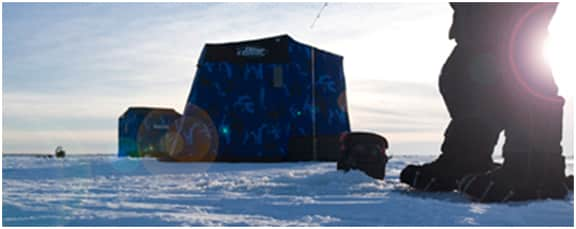“Uncompromising” Otter Ice Fishing Shelters
OutdoorHub 09.12.12

Roto-molding. It’s a time consuming process. But then again so is aging an Arturo Fuentes Opus X or cask of Jameson 15-year pot-stilled Irish whiskey. In ice fishing shelters and sleds, good things come from a number of manufacturers using various faster and less expensive molding processes. Great things, on the other hand, come from Otter Outdoors’ artisan, patently-patient roto-molding processes.
Otter believes in building from the ground up. Or, shall we say, ‘the ice up…’ The superior manufacturing process by which every Otter Sled base is created uses a proprietary blend of polyethylene specially formulated for bluntly cruel ice fishing conditions. Thermoforming can’t say that; nor can those who blow-mold. With that in mind, the first question you should ask when purchasing a new ice fishing shelter is, “What’s the base made out of?” If the answer isn’t roto-molded polyethylene, move along.
VP of Sales & Marketing Chris Witte elaborates on the critical thinking and ruggedness that go into the sled bases. “They’re molded with consideration for worst case scenarios. Hitting a rock or ice break at high speed is inevitably going to happen. Our sleds are designed and manufactured to make those encounters a non-event. That attribute comes from having more material in the corners than a thermoformed or blow-molded sled.” Add to that, uniformed wall thickness and the overall toughness is further amplified.
Speaking of wall thicknesses, the same staunch mindsets at Otter aren’t busy chasing around the thinnest, cheapest materials on the market, either. Unlike cutting a deck of cards, thin doesn’t win. Witte explains: “Flatly, our fabric is thicker and of a superior make. The new Xtreme Thermal Shells provide a great example. While most competitors use a ‘sonic seal’ that flattens the insulating layer to the point of impotence and simply cannot hold thermal material in place, Otter’s are sewn and quilted which maximizes the insulating layers effectiveness.” That’s like comparing Betsy Ross’ first handmade American flag to synthetic yard versions on Independence Day.
Supporting the durable fabric on Otter ice fishing shelters is industry best square aluminum tubing -all others being round and less sturdy. Again, Witte enlightens as to why Otter doesn’t cut corners- pun intended. “It’s really just a simple physics lesson in flex modulus strength. Simply put, our anodized, pure aluminum square tubes are more resistant to kinking and bending than round tubes.” Anodizing is not purely for cosmetics, either. The process actually fills micro pockets in the aluminum, which thwarts frosting, keeping the poles smooth and dry.
In a word, Witte describes Otter Outdoors’ mentality toward engineering and manufacturing ice fishing gear as “uncompromising.” And that’s exactly what you want to hear from the leader.

